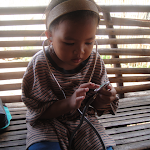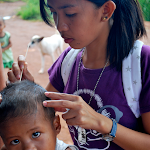07
Sep 2010
Community Nursing 101
 What comes to your mind when you hear the “wang-wang” siren sound coming from a speeding vehicle? You may think it’s the president’s car, a firetruck, a police car, or an ambulance, right? When I worked in a hospital, every time I heard that sound I would cross my fingers and secretly hope that it wasn’t an ambulance because when it was, we would normally encounter emergency or critical cases enough to make our heads spin.
What comes to your mind when you hear the “wang-wang” siren sound coming from a speeding vehicle? You may think it’s the president’s car, a firetruck, a police car, or an ambulance, right? When I worked in a hospital, every time I heard that sound I would cross my fingers and secretly hope that it wasn’t an ambulance because when it was, we would normally encounter emergency or critical cases enough to make our heads spin.
I worked with other nurses and doctors, and everyone on our team worked together to care for our patients. If the siren sounds became louder as the vehicle came closer to the hospital, my team and I would start preparing the basic paraphernalia that we’d initially need for a new patient. My work as a nurse included conducting health assessments and administering medical treatment and medications. I used a variety of skills in performing different tasks depending on the doctor’s orders. Sometimes our patients were in bad shape and required a lot of care but I always drew strength from knowing that I was working in cooperation with a team of health professionals. Having their company and guidance gave me the presence of mind and focus to perform all the tasks that I needed to carry out.
 Four months ago I began working as a nurse with Roots of Health / Ugat ng Kalusugan. I was initially a bit nervous about working outside a hospital setting and within a community, because I wasn’t sure what to expect. There are a lot of differences between my past experiences and my realities now.
Four months ago I began working as a nurse with Roots of Health / Ugat ng Kalusugan. I was initially a bit nervous about working outside a hospital setting and within a community, because I wasn’t sure what to expect. There are a lot of differences between my past experiences and my realities now.
As a nurse in a community setting, I usually go to the houses of my clients, unlike in a hospital setting where patients come to us for treatment. In the hospital, I worked with a team, but now I work on my own and don’t have anyone who I can double-check with if I have a question about something. In the hospital, there were doctors and nurses who split up different tasks. In Pulang Lupa, I’m on my own and carry out all the health procedures including conducting basic interviews, performing check-ups, collecting pap-smear specimens, giving pre-natal and post natal care, looking after newborns and making sure their umbilical cord stumps are healing properly, dispensing different contraceptives to women who want them, and cleaning wounds and minor scrapes the kids have. It’s a lot of work for one person!
 There are other differences too. The hospital I worked in was a sterile environment and I had access to a lot of high quality hospital equipment. In Pulang Lupa, if I’m not in people’s houses, I run my clinic in a small room near one of the churches. I have equipment, but mostly just the basics, and the environment isn’t sterile. Because of this, I can’t always perform diagnostic tests and deal with serious emergencies as I could in a hospital.
There are other differences too. The hospital I worked in was a sterile environment and I had access to a lot of high quality hospital equipment. In Pulang Lupa, if I’m not in people’s houses, I run my clinic in a small room near one of the churches. I have equipment, but mostly just the basics, and the environment isn’t sterile. Because of this, I can’t always perform diagnostic tests and deal with serious emergencies as I could in a hospital.
However, there are real advantages to the work I am doing in a community setting. Instead of treatment only, which was the main hospital focus, in Pulang Lupa I can work on Primary and Preventative care. I teach my clients about healthy lifestyles, eating balanced and nutritious foods, the importance of exercise, good sanitation, hand washing and other preventive measures. Roots of Health provides these services for free to community members, which is beneficial to them as most of them cannot afford to go to a hospital.
Despite my initial nervousness at my new job, I’ve found that the work I’m doing now is extremely fulfilling. The longer I work in Pulang Lupa, the more chances I have to talk with the residents. Unlike in the hospital where I only treated the specific problem the patient had at that time, now I can gain an understanding of the lives and lifestyles of my clients. I have time to observe and evaluate their activities, and work with them to find ways to improve their overall health and well-being.
Sometimes I still wish I had other medical professionals to consult with, but I trust my knowledge from school, and I consult my books and recall past experiences from the hospital and a rural health unit I worked in to help me perform my job well and help me establish rapport with the people in Pulang Lupa. In four months of serving them as their main caregiver for health matters, I have realized that I definitely feel the satisfaction of my profession even though I’m not wearing a white uniform with a nurse’s cap or working in a big sterile hospital. Working in a community setting is allowing me to help people who don’t normally get help, and to make a real difference in their lives.





Recent Comments